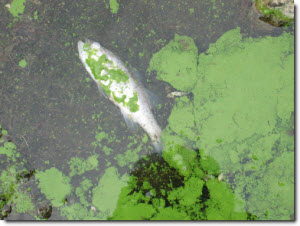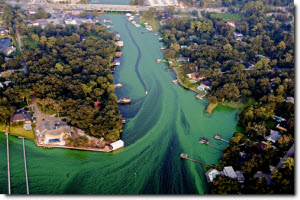The Effects: Environment


Nutrient pollution fuels the growth of harmful algal blooms which have negative impacts on aquatic ecosystems.
Direct exposure to algae
Harmful algal blooms sometimes create toxins that are detrimental to fish and other animals. After being consumed by small fish and shellfish, these toxins move up the food chain and can impact larger animals like sea lions, turtles, dolphins, birds and manatees.
Even if algal blooms are not toxic, they can negatively impact aquatic life by blocking out sunlight and clogging fish gills.
Dead zones and hypoxia
Nutrient pollution can create dead zones - areas in water with little or no oxygen - where aquatic life cannot survive. Also known as hypoxia, these areas are caused by algal blooms consuming oxygen as they die and decompose. Aquatic animals - particularly young fish and seafloor dwellers like crabs and clams - must leave the affected area to survive.
Over 166 dead zones have been documented nationwide, affecting waterbodies like the Chesapeake Bay and the Gulf of Mexico. The Gulf of Mexico dead zone is the largest in the United States, measured to be 5,840 square miles in 2013. It occurs every summer because of nutrient pollution from the Mississippi River Basin, an area that drains 31 upstream states. The Mississippi River/Gulf of Mexico Hypoxia Task Force coordinates nutrient management in this area.
Acid rain
Acid rain, caused by nutrient pollution in the air, damages lakes, streams, estuaries, forests and grasslands across the country.
Air pollution
Airborne nitrogen compounds like nitrogen oxides contribute to the formation of other air pollutants such as ground-level ozone, a component of smog which can restrict visibility. Wind and weather can carry ozone many miles from urban to rural areas. Ozone pollution can damage trees and harm the appearance of vegetation and scenic areas.
